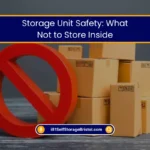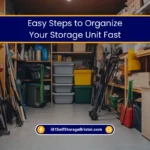Okay, friend. Let’s talk storage. You’re probably staring at two options on a website: one price that seems pretty reasonable, and another that’s… well, a bit more. And you’re thinking, “Do I really need the fancy one?”
I’ve been in this business a long, long time. I’ve seen what happens when people make the wrong choice. I’ve also seen people save a bundle by knowing exactly what they need. So let’s get into it. This isn’t a sales pitch. This is me giving it to you straight.
Why Climate-Controlled Storage Beats Regular Units?
First off, forget the word “fancy.” Climate control isn’t about being fancy. It’s about being smart. It’s about understanding that heat, cold, and especially dampness are like a trio of tiny, invisible vandals that love to ruin your stuff.
A standard storage unit is an amazing, secure shed. It’s fantastic. But it’s not sealed off from the world. On a boiling hot day, it gets hot. On a freezing night, it gets cold. And when it’s muggy out? That moisture gets right in there.
A climate-controlled unit is different. It’s inside a building, for one. It has heating and air conditioning that kick on to keep the temperature steady, usually between a cool 55 and a warm 80 degrees. But the real hero is the dehumidifier. It sucks that sticky, nasty moisture right out of the air. That’s the thing that saves your bacon.
Items That Always Need Climate-Controlled Storage
Here’s my absolute, non-negotiable “you need climate control” list. If you’re storing any of this, just do it.
Wood. Any nice wood
I cannot stress this enough. That solid wood dresser you inherited? Your dining room table? Wood breathes. It swells up like a sponge in the humidity and then shrinks back down when it’s dry. After a few cycles of this, it decides to split. Or warp. Or for the drawers to never quite fit right again. It’s a slow-motion disaster. I once had a customer store a beautiful, hand-carved hope chest in a standard unit over a particularly damp summer. When she opened it, the lid wouldn’t close. The wood had swollen and never gone back. It was heartbreaking.
Anything with a circuit board
TVs, computers, stereos, that fancy coffee maker you can’t live without. Moisture in the air leads to corrosion on those tiny, delicate parts. You won’t see it happening. You’ll just show up eight months later, plug it in, and get a big fat nothing. Silence. A black screen. That “savings” on the unit just cost you a new television.
Your memories
This is the big one. Photo albums. Those boxes of letters from your grandparents. Your kid’s first drawings. Paper and moisture are a nightmare combination. Pages stick together and rip. Photos get a weird, cloudy film on them and curl up at the edges. Mold shows up as little brown spots that you can never, ever get out. You cannot replace those things. The few extra dollars a month is the cheapest insurance you will ever buy for them.
The sensitive stuff
Leather jackets that can grow mold. Musical instruments that will fall out of tune permanently. Wine that will turn to vinegar. Artwork. Important documents. If you’d be upset if it was ruined, it belongs in a stable environment.
Now, when are you totally fine to save your money?
- Stuff that’s already tough: Your lawnmower. Your patio furniture. Your toolkit. Your Christmas decorations in those big plastic bins. If it was designed to live in your garage or attic, it’ll be perfectly happy in a standard unit.
- Most kitchen stuff: Dishes, pots, pans—they’re fine. Just, for the love of all that is good, make sure they are 100% bone dry before you seal them up in a box. Trapped dampness is what causes problems.
- Things in sealed plastic totes, not cardboard: A good plastic tote with a click-lock lid is a warrior against dust and moisture. For storing clothes, books you don’t love that much, or kids’ toys, they are perfect. Cardboard boxes are basically sponges that pests love to chew on. Avoid them.
Here’s the real-world advice you came for
Think about two things: your local weather and how long you’re storing stuff.
Is your summer a humid, sticky nightmare? Does your winter get bitterly cold? Then the swing between seasons is brutal. Climate control is a much smarter bet.
Are you just stashing things for a few months between moves? You can probably get away with more. Are you storing things for a year or more? That’s a long time for those invisible vandals to do their work. Don’t risk it.
And here’s my final thought
At Bristol VA Self Storage, we get it. This is your stuff. It matters to you. So when you walk in, we’re not going to try and upsell you. We’re going to ask you what you’re storing and for how long. And then we’re going to give you our honest, human opinion.
Because we’re not just renting space. We’re helping you keep your things safe. And we take that personally.
Hope this helps. Really. Now you know what to ask for.













0 Comments